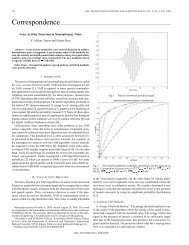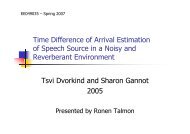Thesis (PDF) - Signal & Image Processing Lab
Thesis (PDF) - Signal & Image Processing Lab
Thesis (PDF) - Signal & Image Processing Lab
You also want an ePaper? Increase the reach of your titles
YUMPU automatically turns print PDFs into web optimized ePapers that Google loves.
2.2. KNOWN TREE REPRESENTATIONS 13<br />
to the root of the tree t. This is the tree-order on V(t) associated with t and r. Note<br />
that r is the least element in this partial order, every leaf x �= r of t is a maximal<br />
element, the ends of any edge of t are comparable, and every set of the form {x|x � y}<br />
(where y is any fixed vertex) is a chain, a set of pairwise comparable elements. The<br />
partial order may also be applied on trees and subtrees. We say that t1 � t2 if t1 ⊆ t2.<br />
From the above definition it is clear that the infimum between vertices is the<br />
common father vertex. When given 2 vertices x and y, the infimum z = x ∧ y is the<br />
vertex that is smaller or equal than x and y, thus z ∈ rtx and z ∈ rty, and there is<br />
no other vertex bigger than z that is smaller than x and y.<br />
2.2 Known tree representations<br />
<strong>Image</strong> representations can be different depending on their purpose. The raw infor-<br />
mation, that is the values of the samples, or pixels, is a too low level representation,<br />
and the image must be described by more elaborate models.<br />
Once the image is segmented, one way or another, the resulting topology must be<br />
described. The usual notion of segmentation is a partition of the image into connected<br />
regions, also called flat zones, and the relations between these regions are meaningful.<br />
In [19], Salembier defined flat zones as connected regions of the gray-level image,<br />
which are determined by a specified connectivity. In binary images these connected<br />
regions are called connected components. Each “flat zone” of a gray-level image can<br />
contain a range of gray levels or a single gray level. The range of gray levels contained<br />
in each connected region is denoted by [gray level, gray level+∆]. For the flat zone<br />
with single gray level: ∆ = 0; for a range of gray levels: ∆ > 0. Using ∆ > 0, it is<br />
possible to simplify the image by quantizing it into a set of gray scales. Thus all the<br />
pixels in the “flat zone” get the same value of gray level inside the specified range.<br />
This reduces the number of flat zones in the image and can be useful for filtering and<br />
segmentation. Of course, if ∆ > 0, some information is lost because of the gray scale<br />
quantization.<br />
In order to encode the adjacency relations between flat zones, we need to know<br />
when two regions have a common boundary. The classical way to represent this<br />
relation is through a graph, the Region Adjacency Graph (RAG): Each region (flat<br />
zone) is represented as a vertex in the graph and when two regions are adjacent,
















